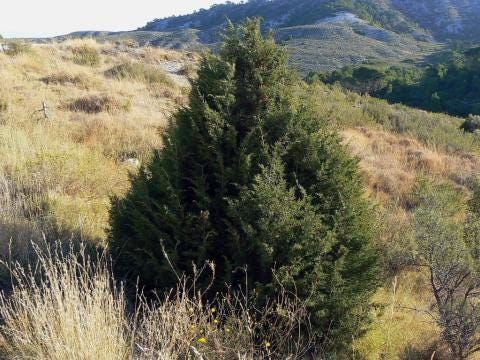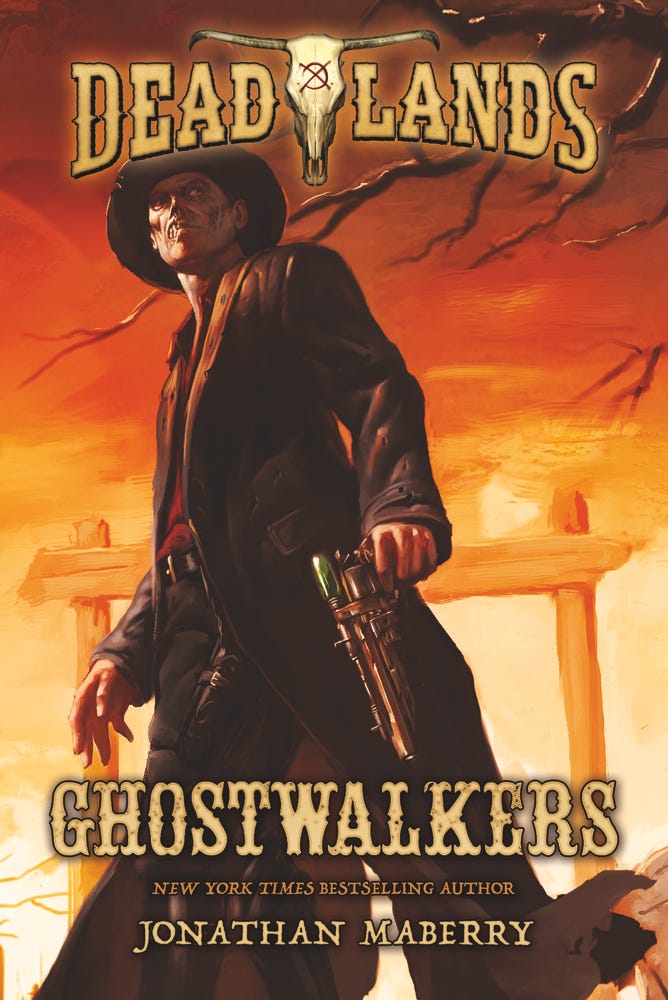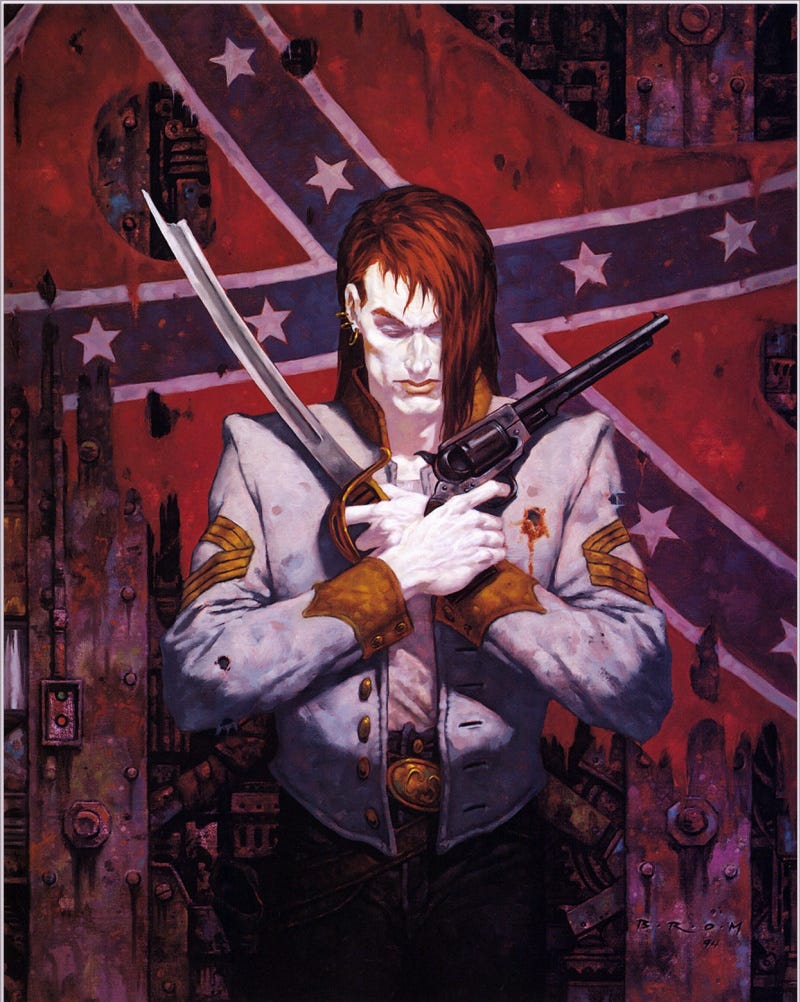[Retro Review] Deadlands: Ghostwalkers: Does It Bring the Big Guns?
Unlike many genre fans, I have a great deal of respect for "media tie-in" fiction. I believe that some of the best science fiction and fantasy fiction has been the result of hard work by a media tie-in author. William King's Gotrek and Felix stories are some of the best Sword & Sorcery fiction I’ve ever read, Diane Duane’s Spider-Man novels are wonderfully entertaining, and no list of praise for this sub-genre would be complete without mention of Paul S. Kemp's tales of Erevis Cale (both the short stories and the novels). These three authors merely scratch the surface of the high quality work that can be found in media tie-in fiction.
One of the things that most impresses me about well written media tie-in fiction is how an author can bring their own spark of originality to a world that has potentially been thoroughly explored by the media creators. Writing a novel tale within a world without being crushed by restrictions created by other creators, or without writing too far outside the box as to not be working within the shared world, takes a high level of skill.
The media tie-in author is writing for two audiences: the existing fans of the setting and fans of the genre who may be unfamiliar with the television show, video game, or role playing game where the story takes place. The job of the author is to make fiction fans of the media fans and turn genre fans into fans of the underlying media. This is a difficult challenge. Fans of a setting can be your harshest critics if they believe that you have written a story that violates the rules of the setting, even if the tale itself is creative and entertaining. Even if the author manages to satisfy the fans of the setting/game, they also need to appeal to the genre fan in the hopes of making them fans of the underlying property. To put it in the crudest terms, media tie-in fiction are both a way to interact with existing fans of the media and are advertisements to future fans. It's a delicate balance between entertainment and advertisement.
I am also a HUGE fan of Weird West settings. My obsession started when I watched old episodes of The Wild Wild West with my dad and Opa and only got stronger when I encountered the Deadlands role playing game setting. It is one of my favorite intellectual properties and was created by Shane Hensley (and friends) while driving home from the GenCon gaming convention when Shane was chatting about a Civil War painting he saw fantasy artist Brom painting at the convention. The painting was done for the cover of Necropolis: Atlanta, a supplement for the Wraith: The Oblivion and Vampire the Masquerade role playing games. It’s an evocative painting that captures the eternal war happening in the shadows of that city in the World of Darkness.
Deadlands was originally published at the peak of the “metanarrative era” of role playing games in the late 90s. At that time, a lot of settings had an ongoing narrative that home campaigns might be able to influence if they reported the results of play in their home games to the publishers. As such, Deadlands has always had related fiction published for the game. I often re-read the "Dime Novels" that were written in the early days of the game. Back in 2015, in preparation for the 20th Anniversary release of Deadlands, Pinnacle Entertainment aggressively release a lot of publications in the media tie-in market. These publications included new comic books and novels as well as a 20th Anniversary rulebook. Given that Deadlands had mostly shifted over to the Savage Worlds system, it was a nice throwback to long time fans. In what can only be described as a major “get,” the novels were published by Tor Books. One of the largest, if not the largest, publisher of speculative fiction.
The first Tor novel was entitled Deadlands: Ghostwalkers. It was the first in a trilogy of novels and was written by talented horror veteran Jonathan Maberry who has written the Joe Ledger and Pine Deep series of books. He's an excellent writer, but how well is he able to combine his own talents with the requirements that come with writing a media tie-in novel?
The Book
Ghostwalkers is the tale of Grey Torrence, a former Union soldier with a haunted past who now wanders the Weird West as he flees the ghosts of his former misdeeds. Torrence is a combination of John Wayne's character Col. John Marlowe in The Horse Soldiers and a Peckinpah badman with a dash of James West. Like Marlowe, he was caught behind enemy lines during the Civil War, but where Marlowe escaped triumphant Torrence's mission ended in failure. In Ghostwalkers, Torrence finds himself continually compelled to do the right thing even against overwhelming odds. He does this in part to atone for his past failings.
This reflexive heroism leads him into companionship with Thomas Looks Away of the Ogala Toyospaye in what could have been a simple Lone Ranger and Tonto tale. Maberry is too talented to fall into that trap and instead of giving us the Native American mystic, he gives us a Native American Mad Scientist more in the mold of Artemis Gordon than Tonto. Thomas Looks Away would have been a perfect role for a younger Graham Greene (RIP…man that hit hard the other day) or Zahn McClarnon. It's a refreshing change from the stereotype and one that signals that the author might be giving us a couple more twists as well.
Torrence and Looks Away, two of the heroes of our tale, are caught in the middle of an apocalyptic time. What separates the Weird West from the Old West is that in 1863 a ritual opened the doors to the Happy Hunting Grounds and created a Hell on Earth where the dead rise from the grave and scientific innovation is fueled by a substance that seems to scream in pain when burned as a means to create power for Weird and impossible gadgets. The Four Horsemen ride the High Country in pursuit of souls and the scariest of them all is the avatar of Death, Stone.
These heroes, and some additional companions, face off against the horrors of the Weird West. They fight the Walking Dead and resurrected Dinosaurs, but no opponent is as fearful as the greed and lust for power of their fellow man.
The Good
Maberry manages to introduce those unfamiliar with the Deadlands setting to the world in a seamless fashion. By focusing the narrative on a character unfamiliar with most of the changes that have taken place in the world, he has a perfect cipher for our own experiences. Maberry also introduces the Weird West in small doses. He doesn't try to convey the entirety of the differences between this fictional West and our own. Instead, he lets us discover how the Los Angeles and California of this world differ from ours at a steady pace. We see the world unfold as the characters encounter it. It's good world building technique used to reveal existing information.
I was particularly impressed with how Maberry was able to show how the influence of the Reckoners, particularly Famine, affected the world in a way that only fans of the game would notice. Genre fans get a good story, but there was a nice easter egg for the media fan. Since the knowledge of the world is passed on by people who live in it, and since they would be unfamiliar with the Reckoners, it was demonstration of solid storytelling. Additionally, modeling some of the characters and narrative on Wild, Wild, West was also a good choice. I don't know if it was intentional or sub-conscious, but I would have loved to watch this book as episodes of that classic show.
The Bad
There were a couple of moments I was pulled out of the text. Given Maberry's use of "Harrowed" characters, read the book to find out what those are, I kept expecting to see the aforementioned Stone (an iconic Deadlands character) around every corner. That never happened, and the story is better for it, but my expectation was a barrier in my reading. That’s on me.
There were also a couple of sentences/phrases that pulled me out of the fiction. The first was when Maberry discussed Juniper trees early. He wrote, "The mingled blurs coalesced into a canopy of Juniper leaves..." which left me wondering if he had ever seen a Juniper. One wouldn't normally use the term "leaves" when describing them. It seemed more like he was describing Oaks than Junipers. That could just be me though.

The second sentence included the phrase "mound of sobbing frilly whites..." as a means of describing clothes that were still wet from a demon rain storm. I think he meant “sopping,” but I can’t be sure. Given that I read an advance copy, I hope this got corrected before the final version. Clothes tend to be sopping wet, though in Deadlands it wouldn't be impossible to find sobbing clothes. In fact, that might make for it’s own horrific tale and one that draws nicely from Manly Wade Wellman’s “The Flat” in a potentially creepy way.
As you can see, "the bad" in the tale is pretty minor. When you are resorting to nitpicking as your criticism, you have read a pretty entertaining piece of fiction.
The Ugly?
Aside from a sex scene that made sense narratively, but was still a little too "because HBO" because it seemed unnecessary as a demonstration of affection, I found it near impossible to put the book down once I started reading. Maberry's tale has wonderful pacing and the right combination of mystery, horror, and action to reflect the underlying intellectual property.
There were only a couple of moments where I could "hear the dice drop" in the background. Grey's heroism sure seems more like a Savage Worlds Hinderance than an actual character trait, but moments like this were rare. If you like Westerns and Zombies, you should love Maberry's work here. I know that I did.
It was an entertaining mash up of The Wild Wild West, John Ford, and Sam Peckinpah. I can think of no higher praise than that.





